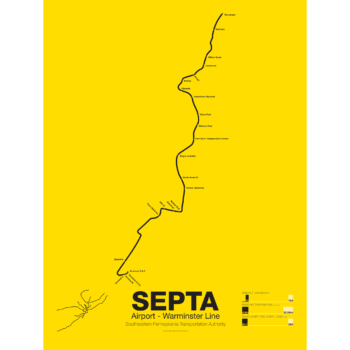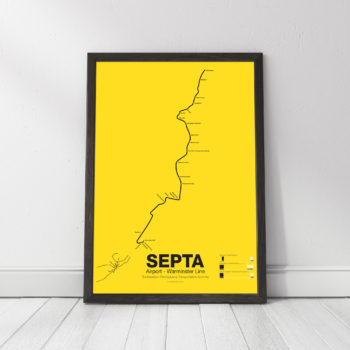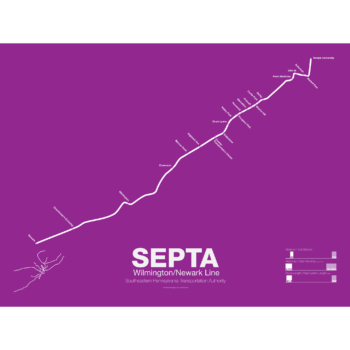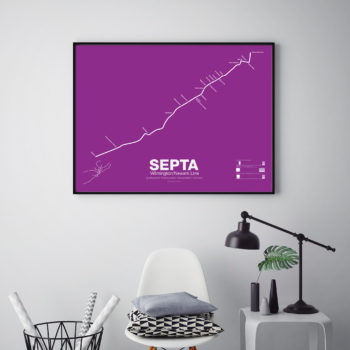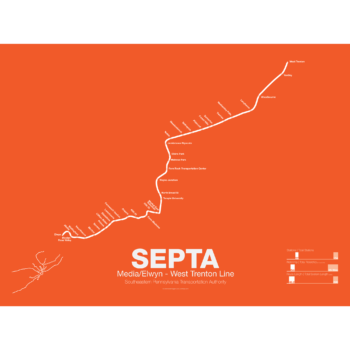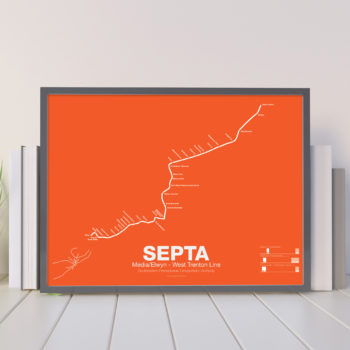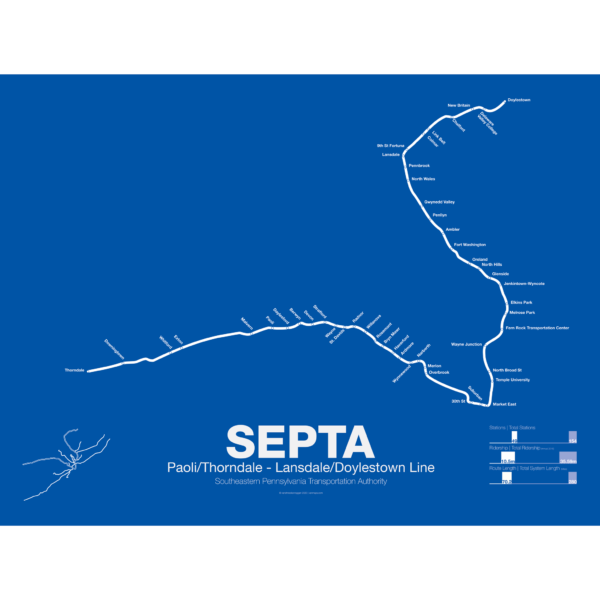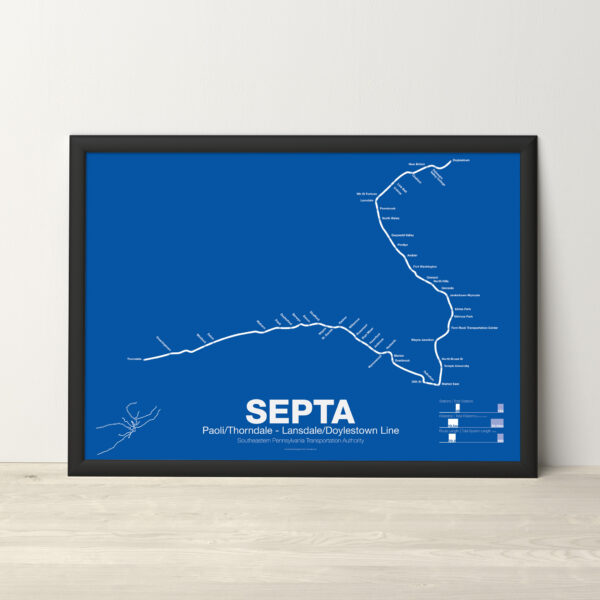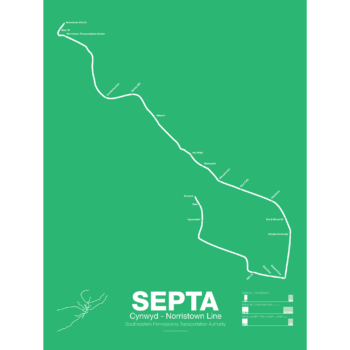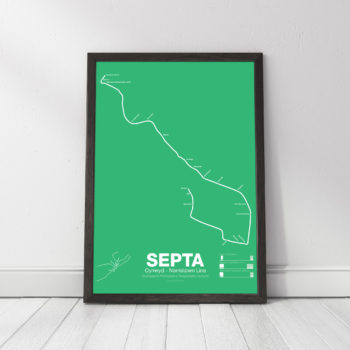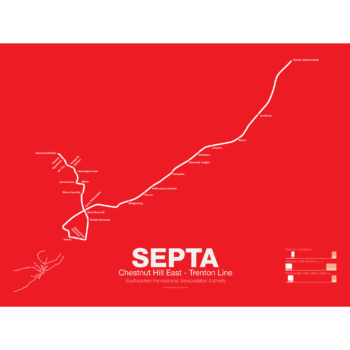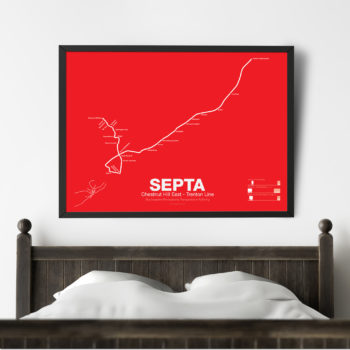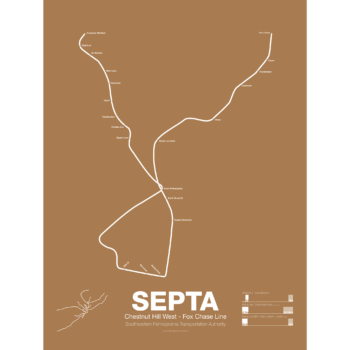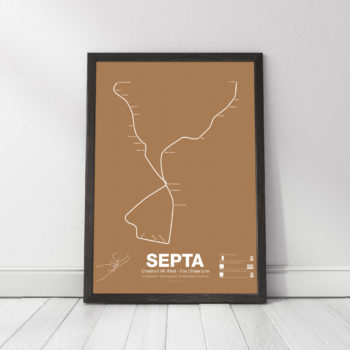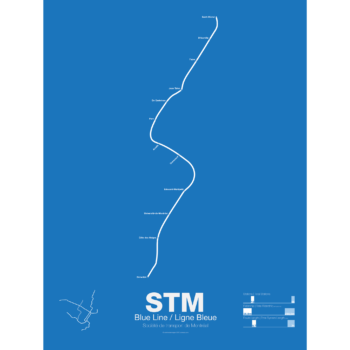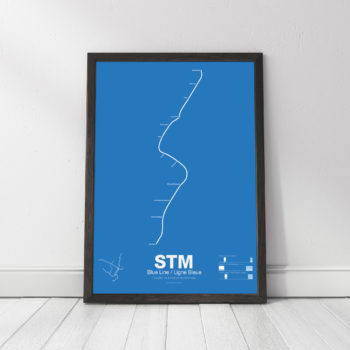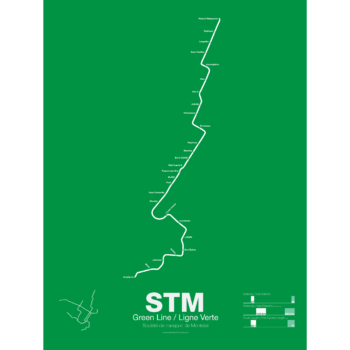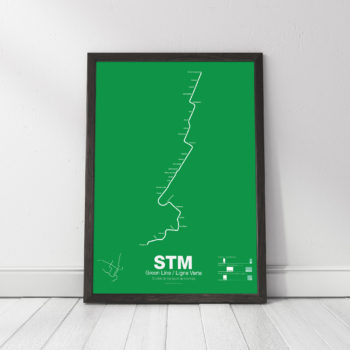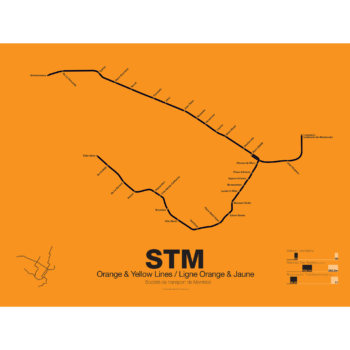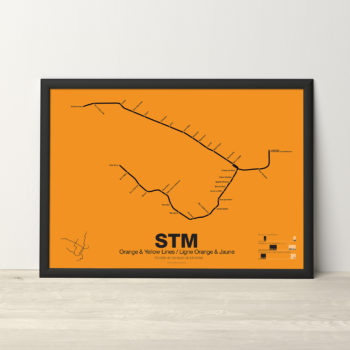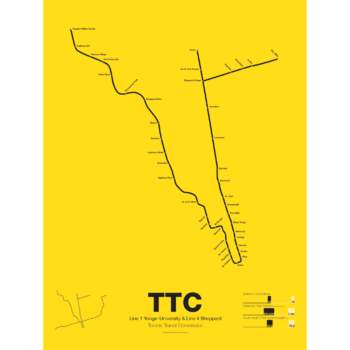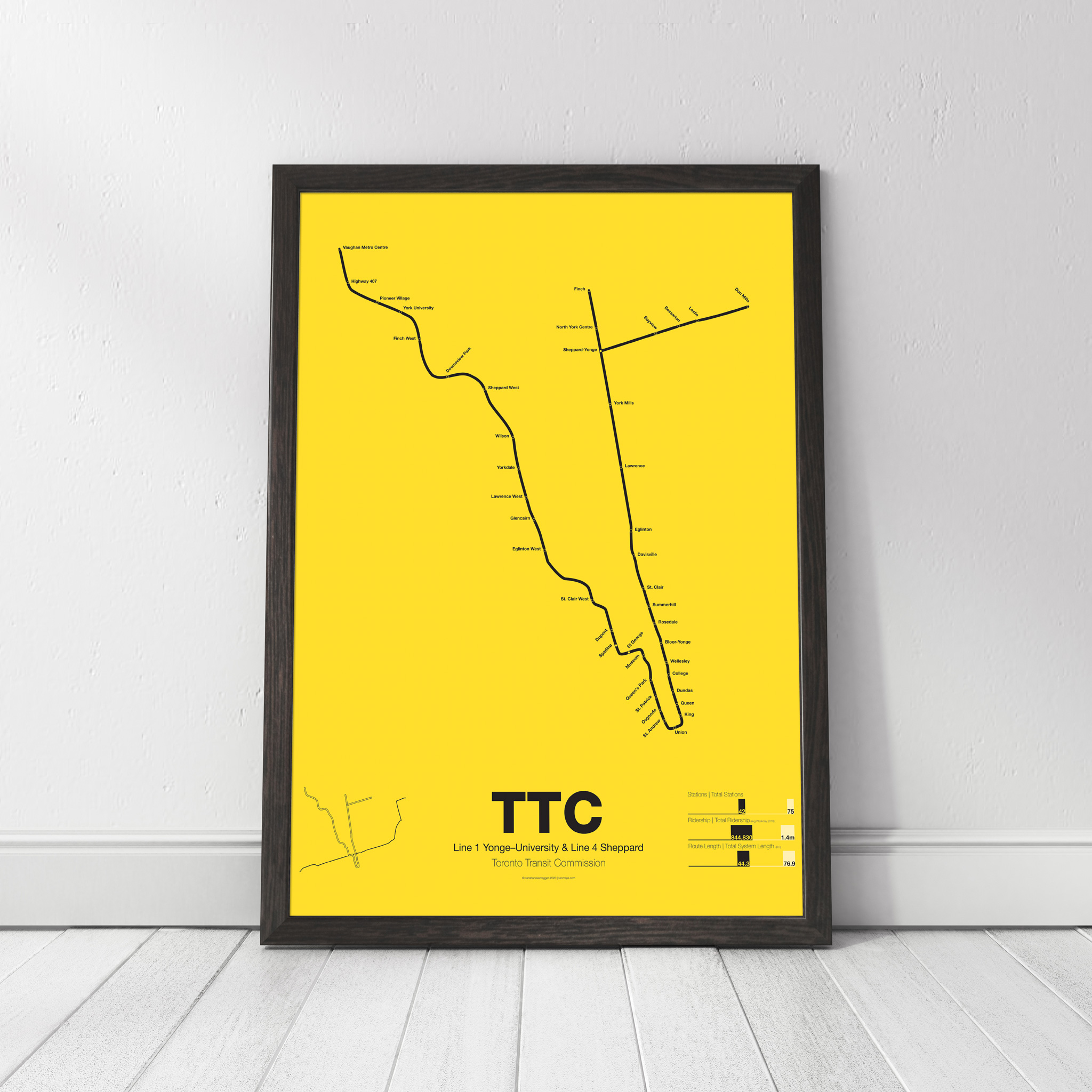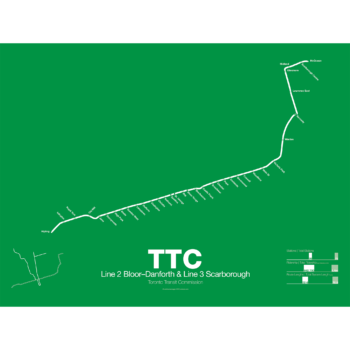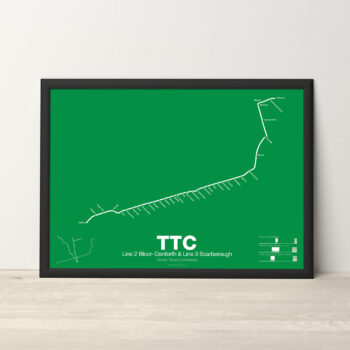poster
105 Products
-
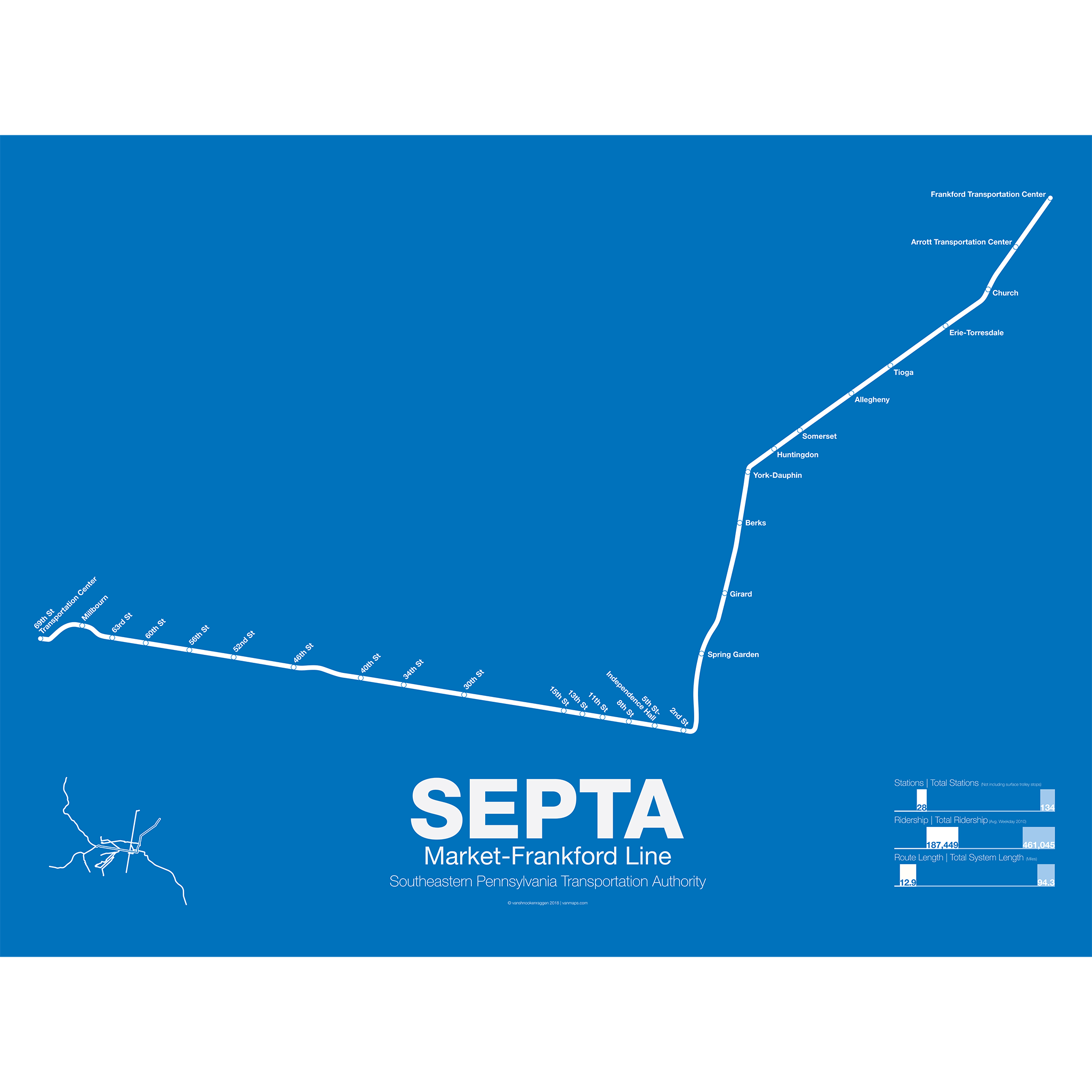
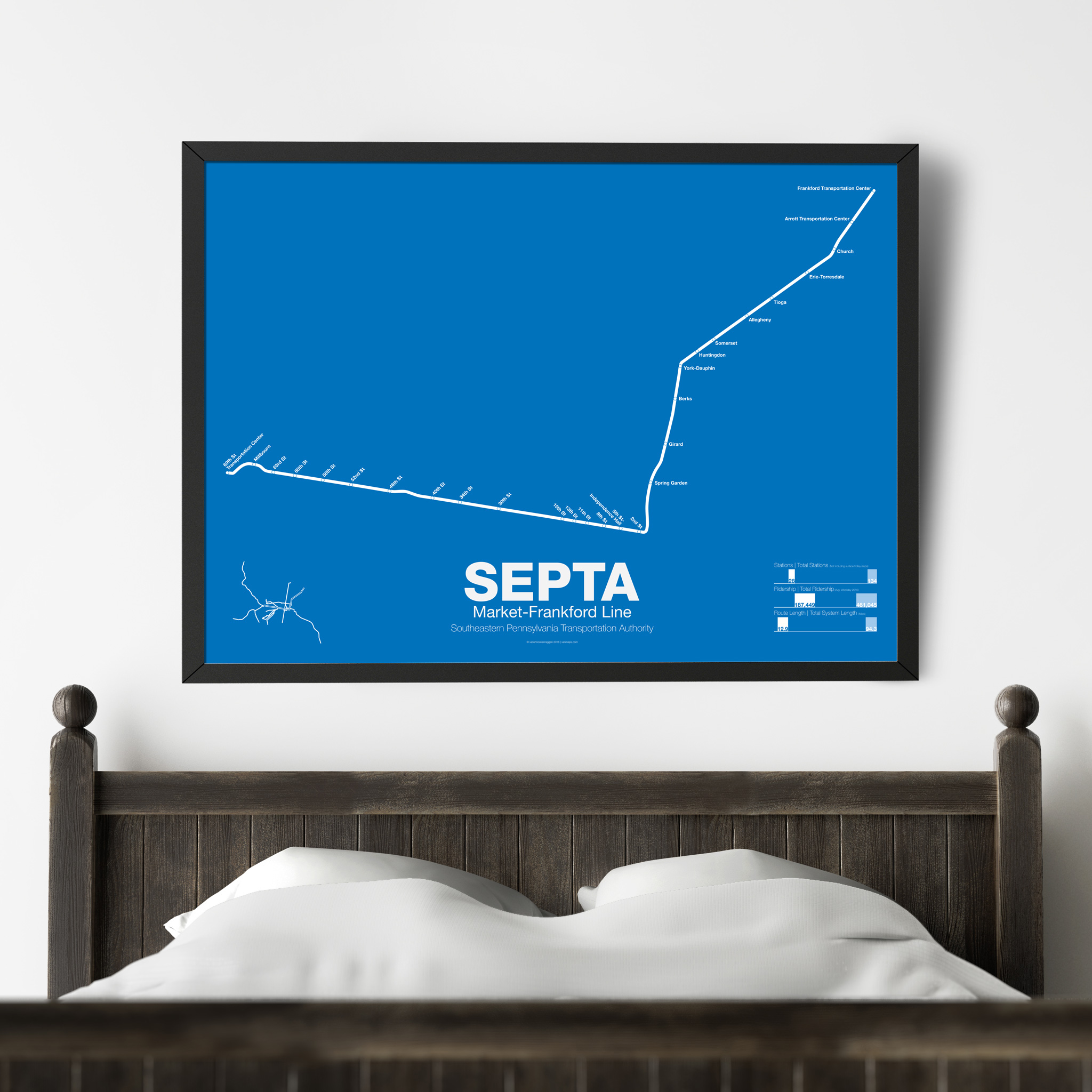 $30.00 – $80.00
$30.00 – $80.00The Market-Frankford Line is the oldest subway in Philadelphia with the initial section from 23rd St to City Hall with an elevated track running across the Schuykill River to the 69th St terminal opening in 1907. The line was built with 4 tracks, two for the elevated and two for the surface trolleys. Originally both sections looped back at City Hall but a year later the elevated trains were extended via subway to 2nd St and to Chestnut St where a portal brought them back to the surface again. Before the Frankford extension was completed, in 1922, the Market Line turned south along Delaware Ave to service the popular ferry terminals. The Frankford extension terminated at Bridge St but was intended to be extended northeast to Rhawn St. When the Benjamin Franklin Bridge opened to traffic in 1926 ferry traffic dropped off and the branch serving the terminals was closed in 1939. The subway was extended west to 46th St (to allow for the removal of the elevated tracks) starting in 1930 but due to budget problems and World War II the extension did not open until 1955. In 1977 the Delaware Ave portal was relocated along the median of the newly constructed Delaware Expressway.
The Market-Frankford Line is unique in that it uses a 5′ 2.5″ rail gauge, standard for trolleys in Pennsylvania, which is different from the standard 4′ 8.5″ gauge which is used by most trains in the United States. Service on the line is skip-stop with A and B trains trading off service at further out stations but all stopping at Center City stations.
Printed on Satin finish 80# cover stock – 220 GSM. Made in the USA! Standard production time is 5 days. Allow more time for shipping.
-
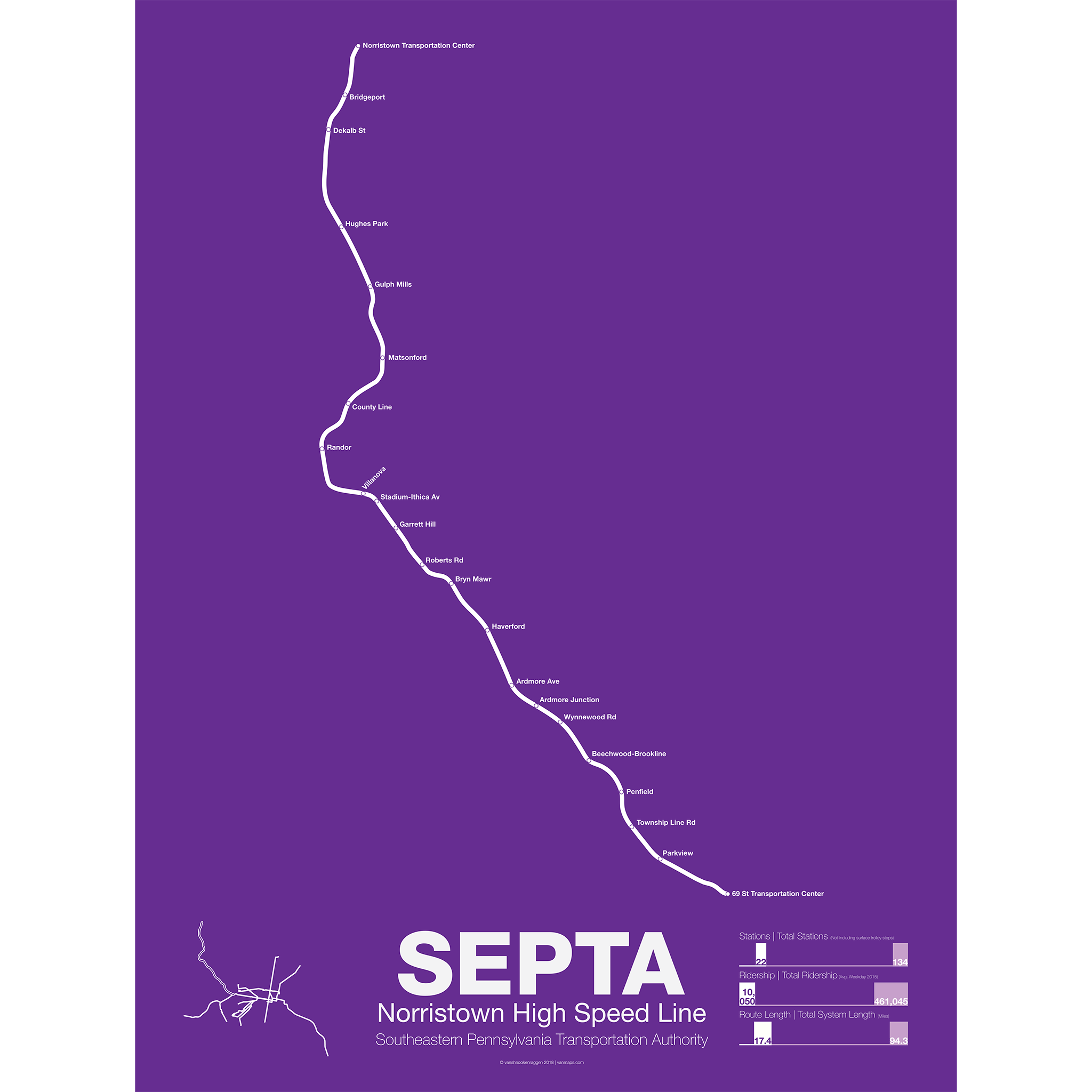
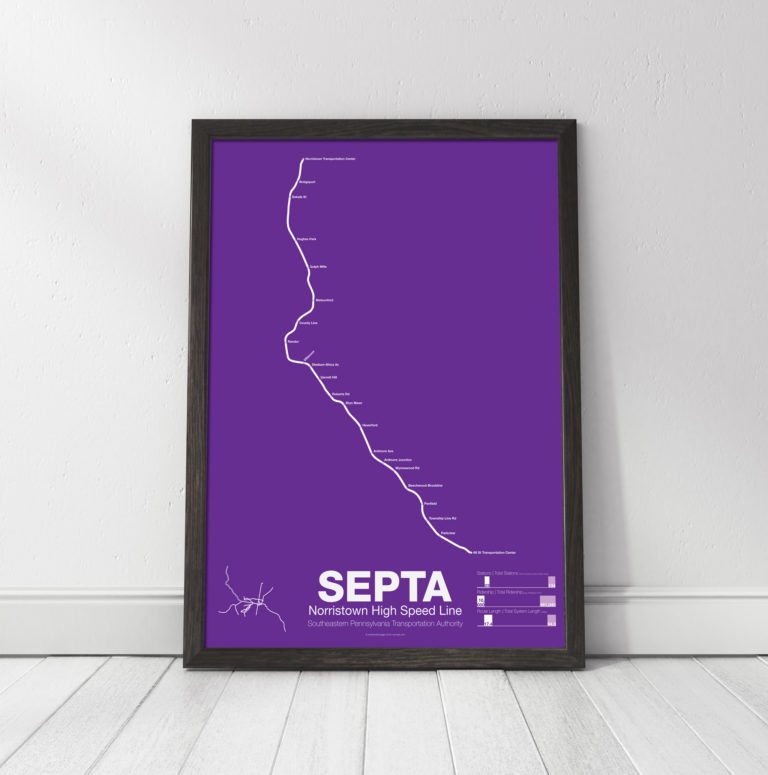 $30.00 – $80.00
$30.00 – $80.00The Norristown High Speed Line (SEPTA route 100) began as a Philadelphia & Western Railroad interurban trolley in 1907 between the new 69th St Market-Frankford terminal and Strafford, PA. In 1912 a branch was built to Villanova and then extended to Norristown. The new branch proved more popular than the Strafford branch which was eventually abandoned in 1956. A year before, in 1955, the line was taken over by the Philadelphia Suburban Transportation Co (more commonly known as the Red Arrow Lines) along with Routes 101, 102, 103, and 104. Route 103 to Ardmore was abandoned in 1966 and Route 104 to West Chester was abandoned in 1958.
The Norristown High Speed Line runs four services, a local, the Norristown Express, Hughes Park Express (short turning at Hughes Park, and the Norristown Limited which only stops at 6 stations between Norristown and 69th St. Unlike the Market-Frankford Line and Routes 101 & 102 (which use a larger 5′ 2.5″ rail gauge) the Norristown Line uses a standard 4′ 8.5″ gauge meaning that service could not be extended into Philadelphia via the existing subway.
Printed on Satin finish 80# cover stock – 220 GSM. Made in the USA! Standard production time is 5 days. Allow more time for shipping.
-
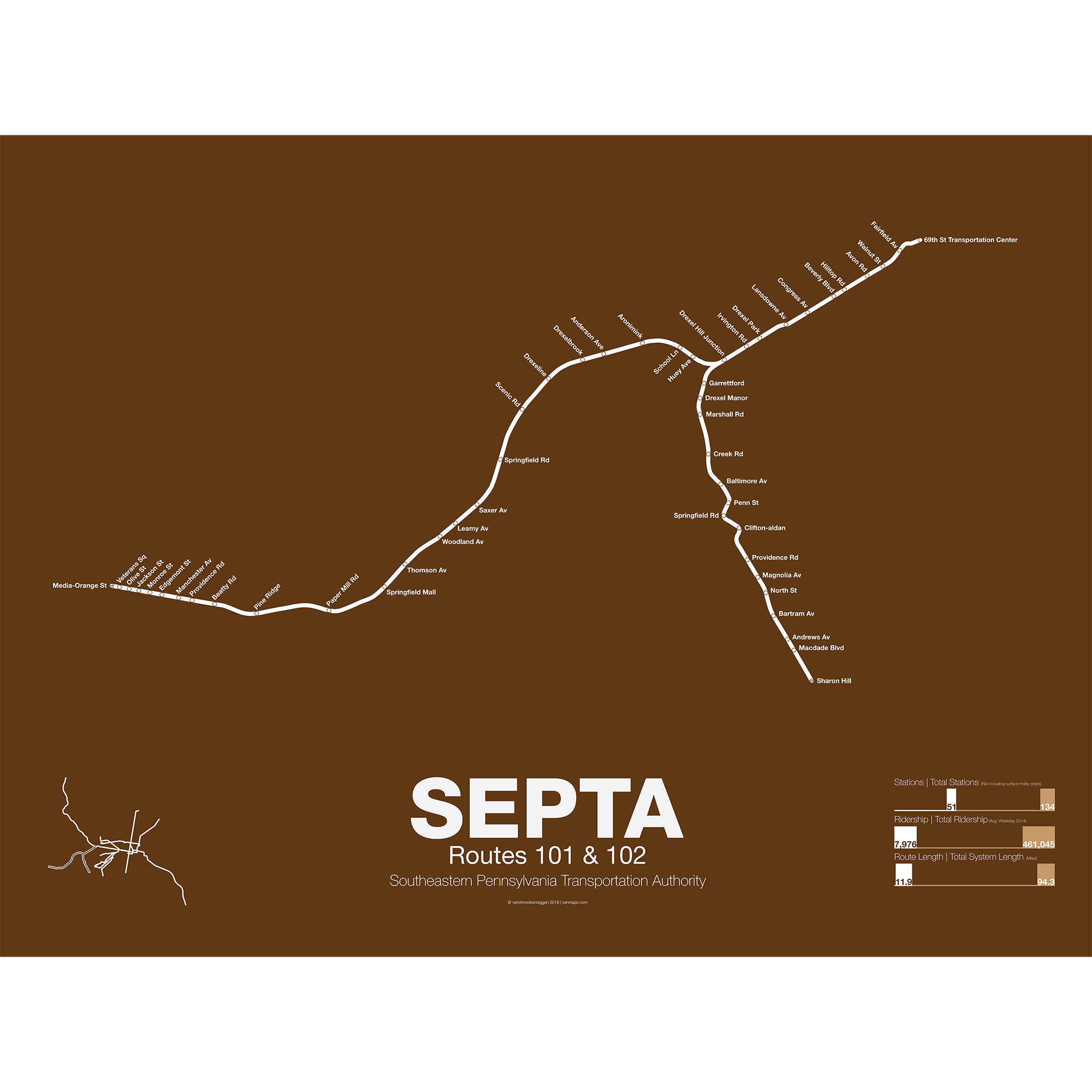
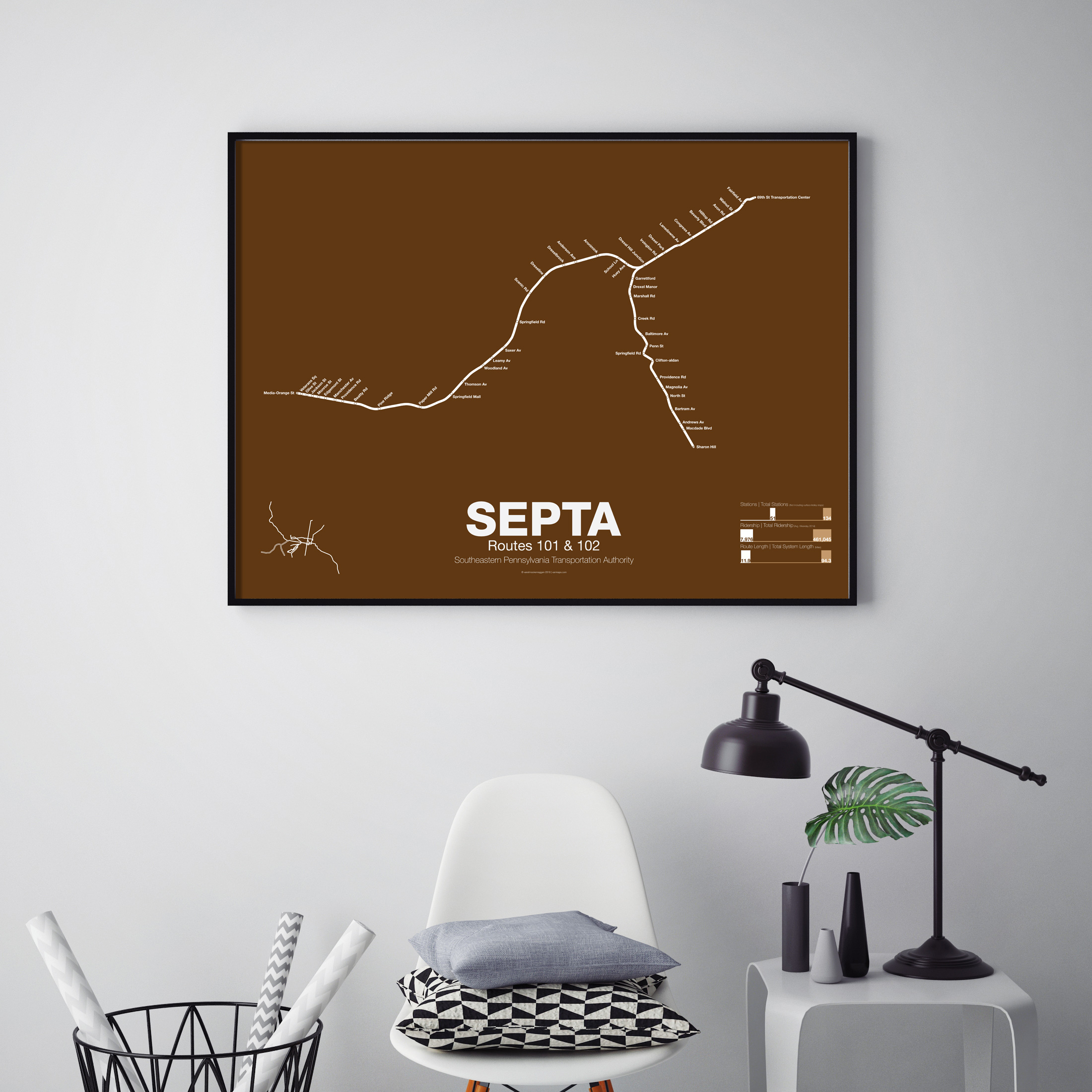 $30.00 – $80.00
$30.00 – $80.00Routes 101 and 102, along with the Norristown HSL, are all that remains of the Philadelphia Suburban Transportation Company lines, commonly known as the Red Arrow Lines. Route 101, which dates from 1913, runs from downtown Media to 69th St Transportation center along a dedicated ROW but within Media along the street. Route 102, which dates from 1906, runs from Sharon Hill to 69th St.
Routes 101 and 102 use the larger 5′ 2.5″ rail gauge which is also used by the Market-Frankford Line along with other trolleys in Philadelphia. The routes run a mixture of local and express services. Until a few years ago SEPTA gave these routes a brown color on the system map but recently changed them to green along with the Subway-Surface lines. To avoid confusion with the other poster the Routes 101 & 102 poster is the original brown.
Printed on Satin finish 80# cover stock – 220 GSM. Made in the USA! Standard production time is 5 days. Allow more time for shipping.
-
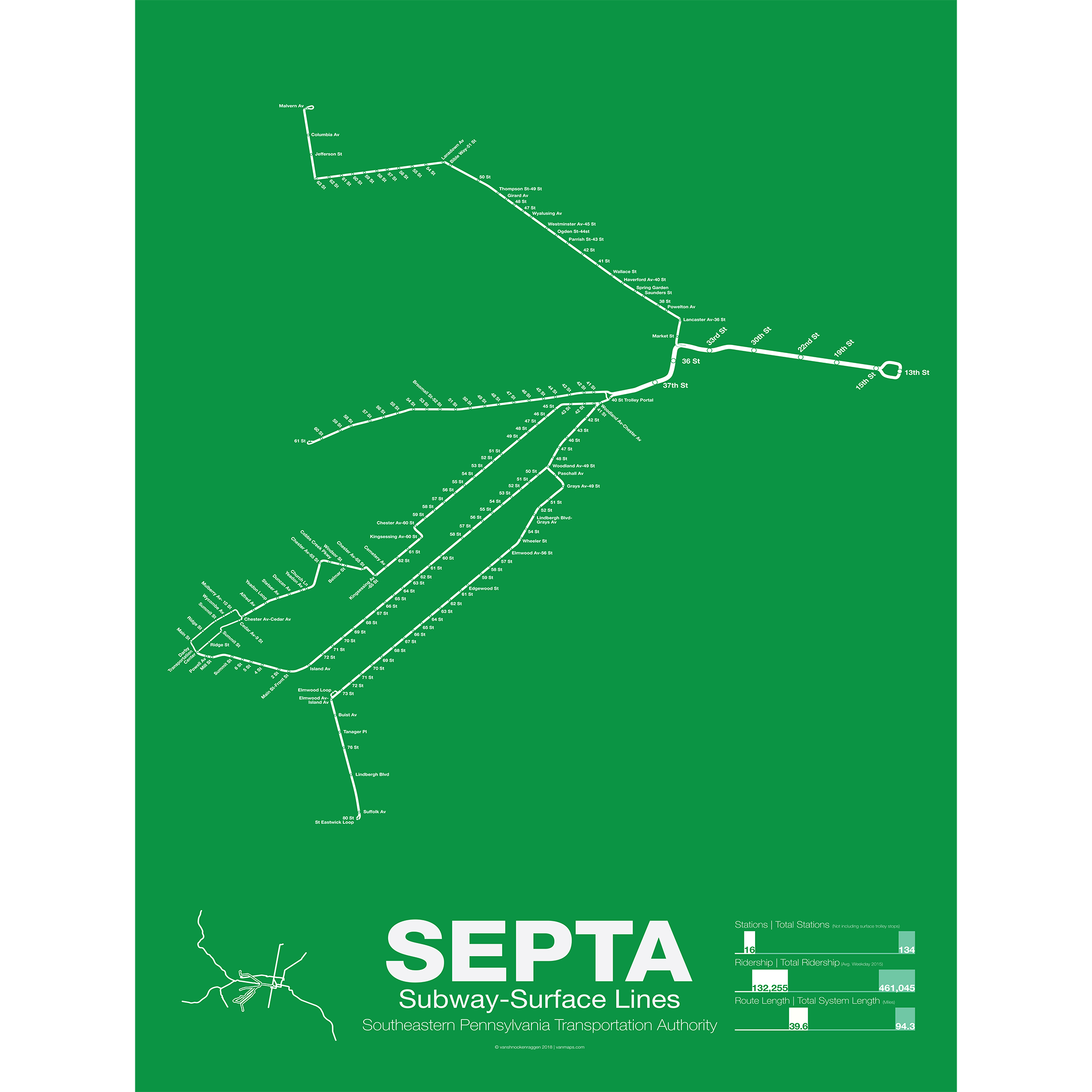
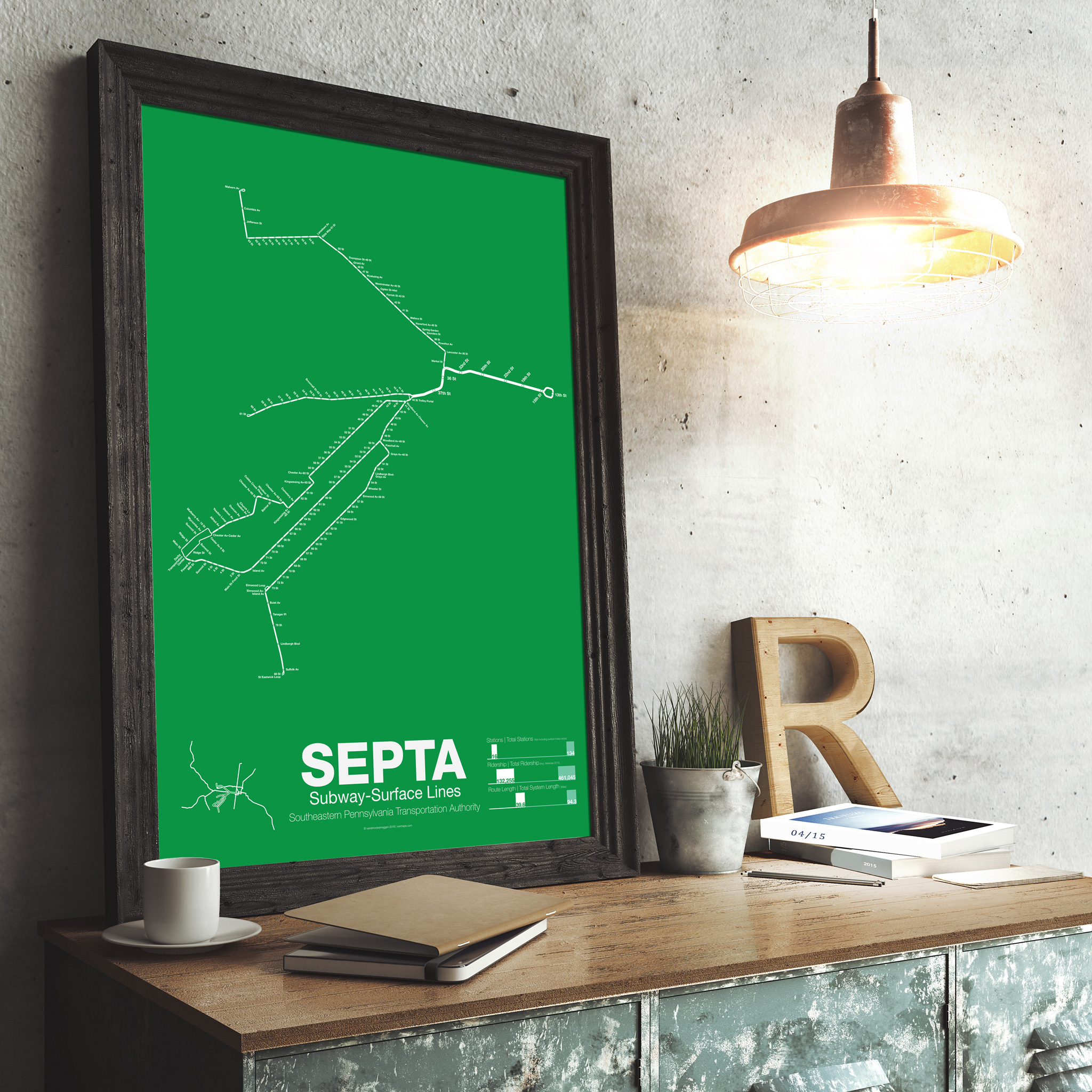 $30.00 – $80.00
$30.00 – $80.00When the Market-Frankford subway opened in 1907 it provided two tracks for surface line streetcars to use with a loop at City Hall. Similar to Boston’s Green Line and San Francisco’s Market St Line the subway uses pre-WW2 streetcar lines as branches. After World War 2, like in most American cities, trolleys were converted to bus lines but in Philly there were many lines which never made the conversion. The streets of Philadelphia are lined with disused streetcar tracks but in West Philly there is still and active network; routes 10, 11, 13, 34, and 36 use the subway and Line 15 crosses the city along Girard Ave but does no use the subway (Line 15 is not included on the poster but is included on the mini-map). The original subway portal was located at 23rd St but when the Market-Frankford Subway tunnel was extended west so too was the trolley tunnel with a new portal at 36th and Ludlow Streets and another at 40th St between Baltimore and Woodland Aves.
The trolley lines have been threatened with replacement via bus or subway extension for decades but due to a lack of funds and popularity the streetcars remain and SEPTA is studying bringing back older lines as well. New cars are being purchased with low floors to help riders in wheelchairs and studies are being made looking at consolidating surface stops to speed up trips.
Printed on Satin finish 80# cover stock – 220 GSM. Made in the USA! Standard production time is 5 days. Allow more time for shipping.
-
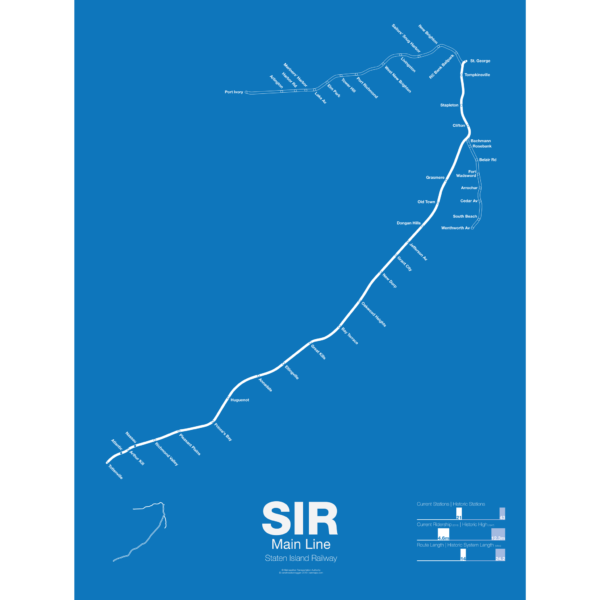
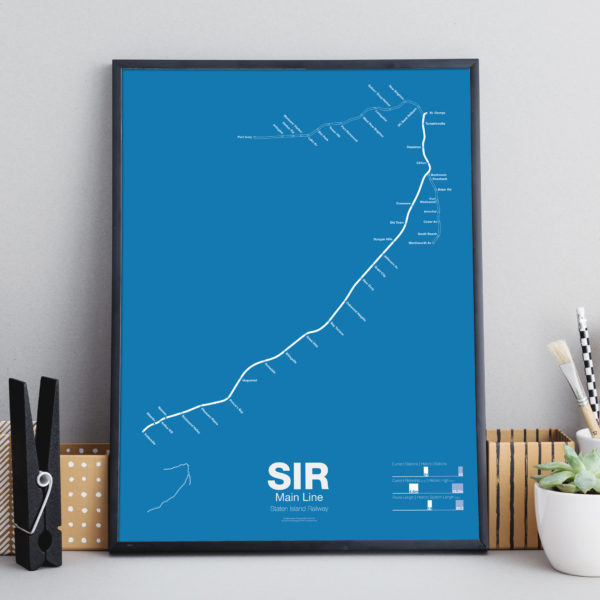 $30.00 – $80.00
$30.00 – $80.00The Staten Island Railway was founded in 1851 as a way to connect the island to Cornelius Vanderbilt’s ferry to Manhattan. It was expanded in the 1880s with a North Shore Branch which connected the island to New Jersey and a South Beach Branch which ran past Fort Wadsworth to the beaches on the islands southeastern shore. The railroad served both passenger and freight traffic. In the 1920s the railroad was electrified in anticipation of a connection to the subway in Brooklyn but the tunnel was never built. After World War II ridership dropped as more residents chose to drive or take cheaper buses over the new bridges to New Jersey. Service on the North Shore and South Beach Branches was ended in 1953, though the North Shore Branch was (and still partially is) still used for freight. Plans have been floated to reactive the North Shore Branch as rail or bus rapid transit but so far nothing has been done.
This poster shows the existing Main Line and two former branches, the North Shore Branch to Port Ivory and the South Beach Branch to Wentworth Ave.
Printed on Satin finish 80# cover stock – 220 GSM. Made in the USA! Standard production time is 5 days. Allow more time for shipping.
-
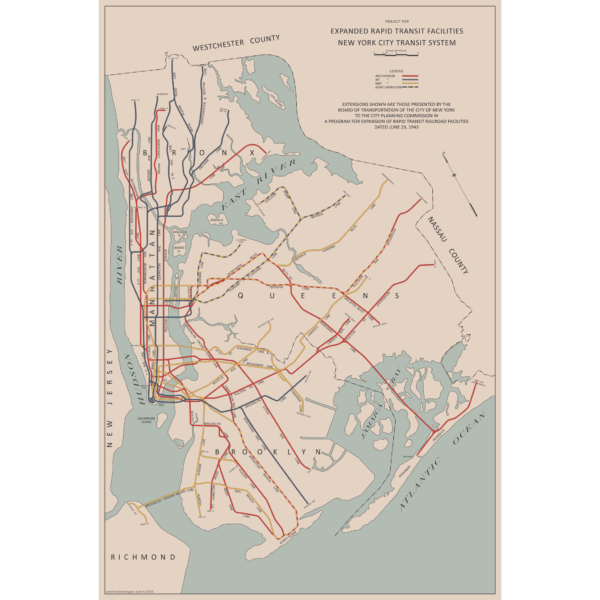
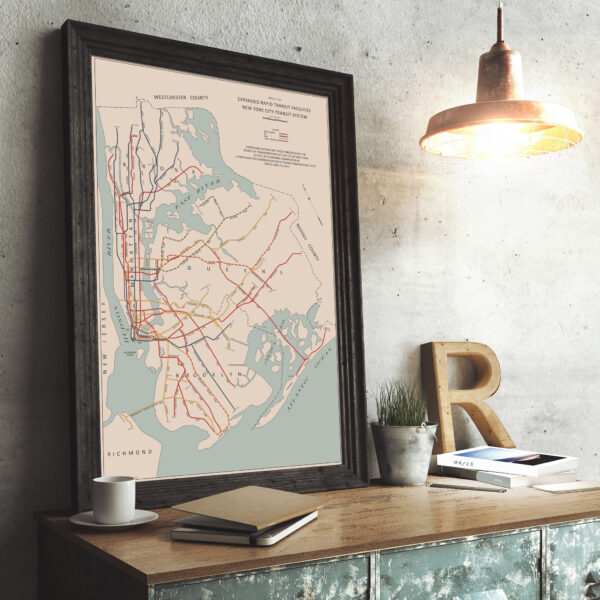 $45.00
$45.00There are two “official” maps of the IND Subway’s expansion plans from the 1930s, colloquially known as the Second System. The plans for expansion evolved greatly as the IND was built. In the 1930s, the New York City subways were still operated by three separate companies. In 1940 the two private companies, the IRT and BMT were purchased by the City of New York under a unification plan. Thus, subway planners were able to imagine physically combining the three systems.
In 1940, John Delaney, Chairman of the Board of Transportation, outlined a new plan, with some additions in 1943. Until now, there were no maps of this plan. So I made one! The 1943 Lost IND Second System Map is probably the last time the city thought about such a large expansion program. The map here is based on the design of the 1939 map, with some changes.
To learn more about the history of this map, and see an outline of the ideas it shows, check out my post.
Printed on Satin finish 80# cover stock – 220 GSM, 24″ x 36″.
-
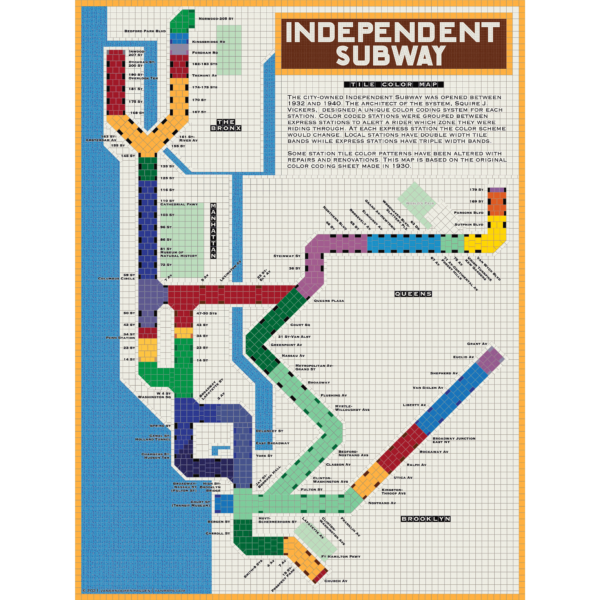
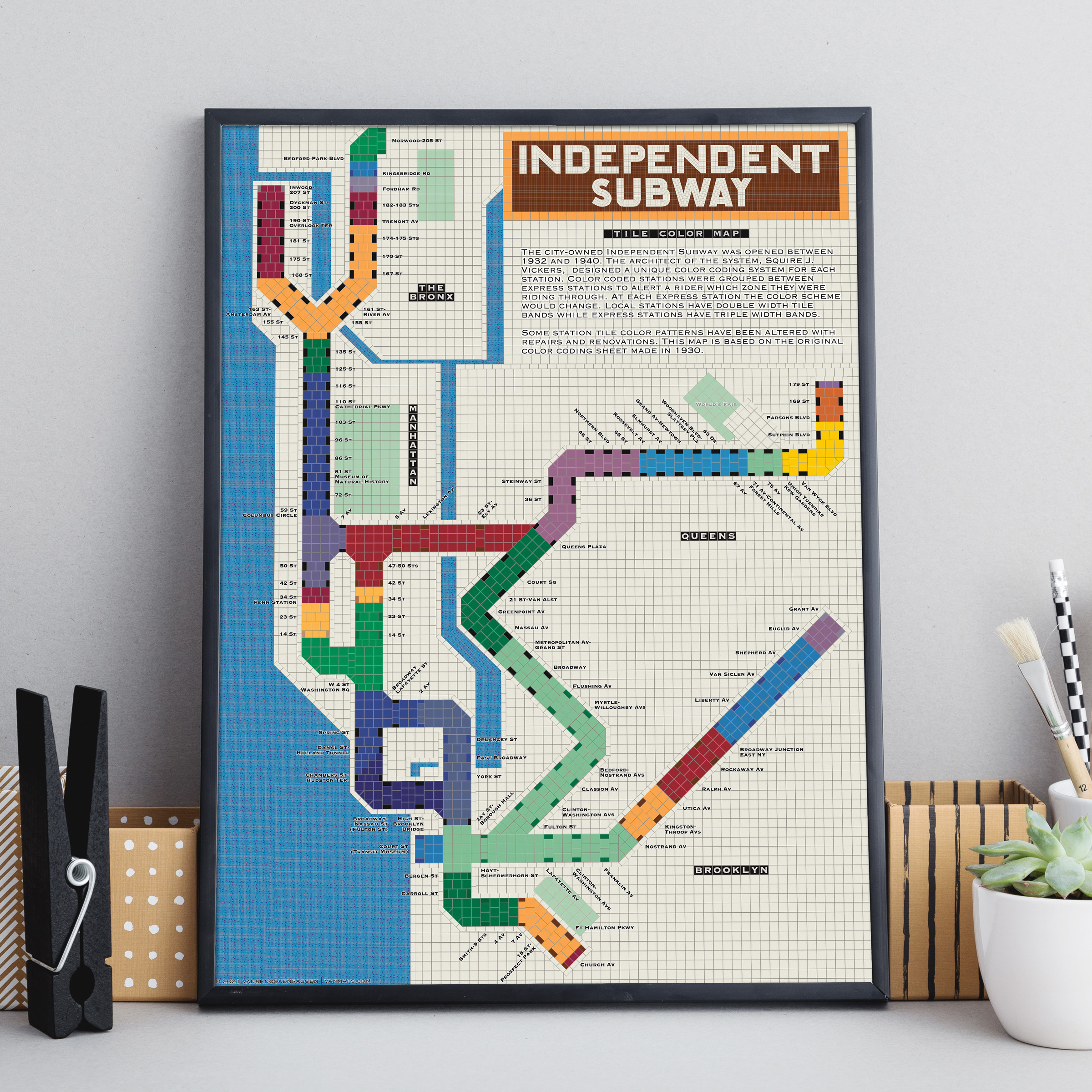 $30.00 – $80.00
$30.00 – $80.00The City of New York built Independent Subway (A/B/C/D/E/F/G trains) was opened between 1932 and 1940. All the subway stations at the time featured tile bands and art unique to each station. The IND’s architect, Squire Vickers, created a new tile pattern based on color theory. He grouped express and local stations with color so that each time a rider rode through an express station the color of the tiles would change. He created a modern, streamlined design which featured two colors per station. The idea was that a rider would recognize their station’s color and know when to get off. This map shows how each color group looks when laid out like a subway map.
Note: The design features an orange tile outline. Some frames may obscure this outline.
Printed on Satin finish 80# cover stock – 220 GSM, 18″ x 24″.
-
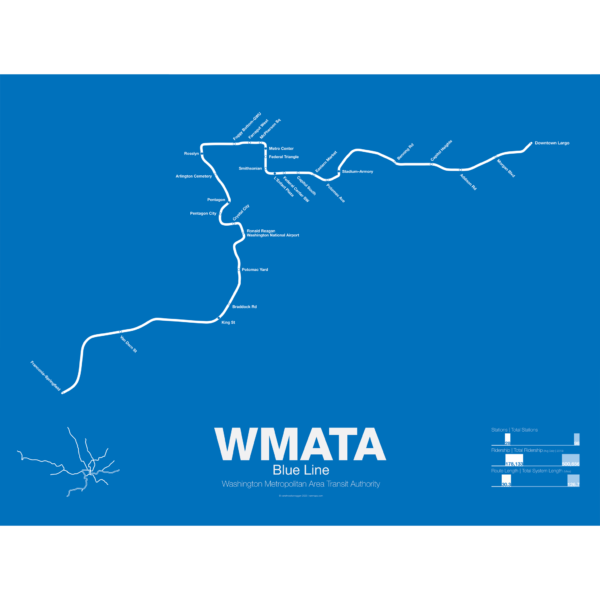 $30.00 – $80.00
$30.00 – $80.00The Blue Line was the second section of the Washington Metro to open; on July 1st 1977 trains began running the familiar serpentine route from National Airport through Roslyn and Metro Center (at the time the only transfer station) to Stadium-Armory. In 1978 an extension to New Carrollton opened and service was split between Blue Line trains running from National Airport-New Carrollton and Orange Line trains running the reverse direction. When the Orange Line extension to Ballston opened a year later Blue Line trains were cut back to Stadium-Armory.
When the Addison Road branch opened in 1980 the Blue Line once again ran only one direction while Orange Line trains ran in the other direction, this time on both branches. In 1983 the Yellow Line was opened down to Huntington. This was originally to be the new terminal for Blue Line trains but due to a car shortage the Yellow Line, which required fewer cars, was extended instead, and this service pattern remains to this day. The extension to Van Dorn St (the originally planned terminal for the Yellow Line) didn’t open until 1991 and was extended to Franconia-Springfield in 1997. A final extension to Largo Town Center opened in 2004.
The Blue Line holds the distinction of the line which shares the most amount of track with other lines (the Orange and Yellow lines). In fact during rush hour service only the Arlington Cemetery station is served exclusively by Blue Line trains. Because of this, planners are looking at digging a new tunnel through central D.C. once the Silver Line opens which is also slated to share Blue Line tracks through downtown D.C.
Printed on Satin finish 80# cover stock – 220 GSM. Made in the USA! Standard production time is 5 Days. Please add more time for shipping.

